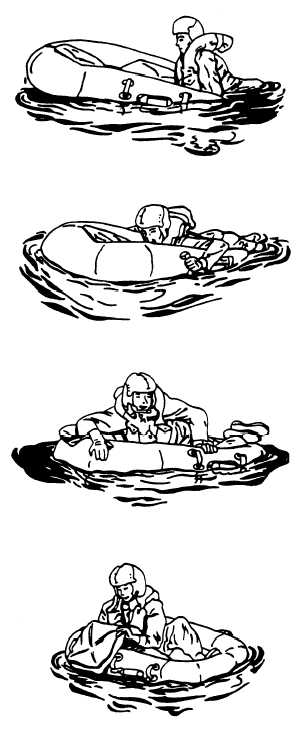chafe the side of the compartment and acts as an
anchor, causing the raft to orbit around it.
Sometimes it is possible to back off the coupling
between the cylinder and the manifold so that the
cylinder releases from the mount. Once the
cylinder has been removed, it is no longer useful
in any way and should be thrown over the side.
This, of course, is under actual emergency
conditions; in a training demonstration, the
cylinder should be saved and recharged for further
use on the training equipment.
In demonstrating their use, also give
instructions on manual inflation of rafts. If
nothing happens after the CO2 cable has been
pulled, the carrying case should be pulled off and
the raft unfolded so that the hand pump will be
accessible. After the pump is removed, the first
compartment to be inflated should be the seat.
This will help keep the raft afloat so that the
remaining compartment can be inflated with the
pump. In attaching the pump, care must be taken
not to screw the pump too tightly to the valve.
If it is too tight, it may freeze and become
impossible to loosen without some type of wrench
or pliers.
BOARDING THE RAFT
The best method for boarding the multiplace
life raft is to use the boarding stirrup located on
the stem of the LRU-12/A, -13/A, and -14 series.
This stirrup will allow the aircrewman to board
the raft from the stern; boarding from the stern
will lessen the possibility y of capsizing the raft (fig.
6-8).
If the raft should capsize, it is best to approach
it from the side on which the CO2 cylinder is in-
stalled. The survivor reaches across the raft and
grasps the righting handle farthest from the cylin-
der. Then, by sliding back into the water and pull-
ing on the righting handle at the same time, the
raft will turn right side up. By using this method,
there will be no chance of the CO2 cylinder hitting
the survivor when he rights the raft (fig. 6-9).
Another important point to remember in right-
ing the raft is to note the wind and take advantage
of it. It is very hard to right a raft against the
wind.
SAFETY PRECAUTIONS IN
BOARDING RAFTS
Extreme care should be taken when boarding
rafts or assisting personnel into the raft from the
water. This is particularly so if these persons are
wearing parachute harness or life vests. Once in
Figure 6-8.—Boarding the
239.355
LR-1 raft.
the raft, all personnel should seat themselves on
the floor and remain in that position if at all possi-
ble. Movement within the raft should be restricted
as much as possible to keep friction at a minimum.
All sharp objects should be collected and
stored, especially jeweled rings, wristwatches, etc.
6-18

